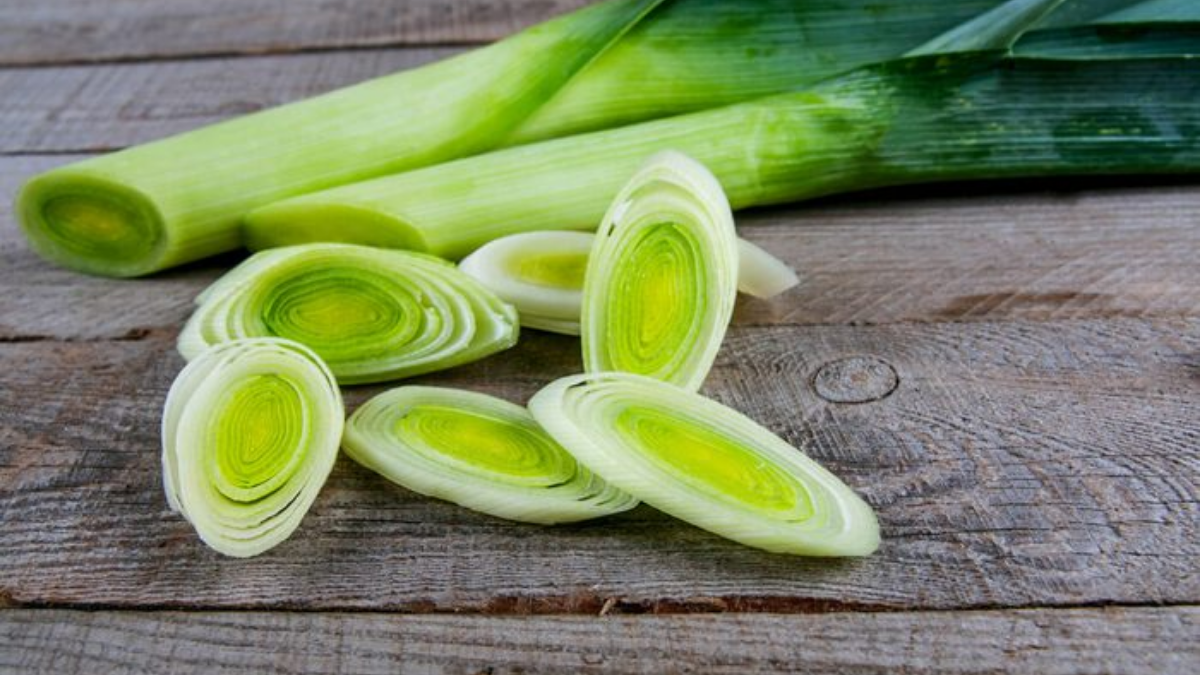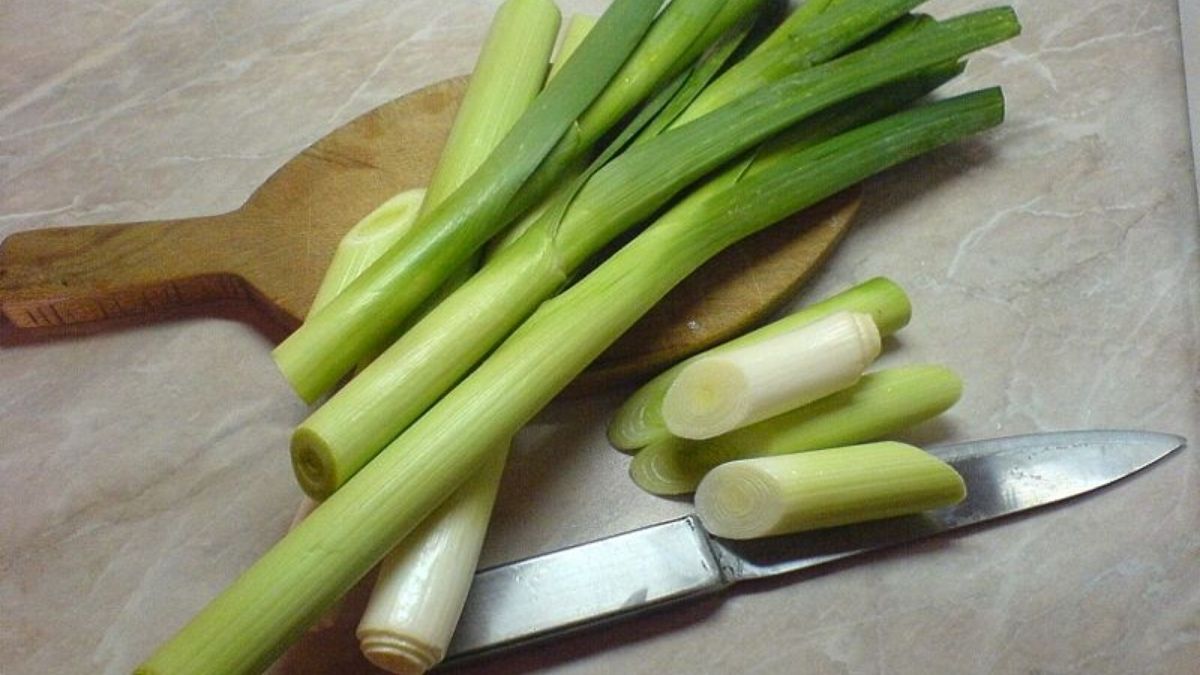Leeks are a member of the Allium family, which also includes onions, garlic, and shallots. They have a mild, sweet flavor that is similar to onions but more subtle. Leeks are a popular ingredient in soups, stews, and other savory dishes, but they are also a nutritional powerhouse. Leeks, which are high in vitamins, minerals, and antioxidants, provide numerous health benefits. In this article, we will look at the leek nutrition facts, including their calorie content, macronutrient profile, and micronutrient content, to better understand why they are such a valuable addition to a healthy diet.
Vitamin K, folate, vitamin B6, and vitamin C are abundant in leeks. Vitamin K is required to produce prothrombin, a type of protein that aids in wound healing by coagulation (clotting). The vitamin may also aid in the preservation of bone mineral density.
Leek Nutrition facts
Here’s an example of a table for leek nutrition facts:
| Nutrient | Amount per 100 grams |
| Calories | 61 |
| Protein | 1.5 g |
| Fat | 0.3 g |
| Carbohydrates | 14.2 g |
| Fiber | 1.8 g |
| Sugar | 3.9 g |
| Calcium | 59 mg |
| Iron | 2.1 mg |
| Magnesium | 28 mg |
| Phosphorus | 35 mg |
| Potassium | 180 mg |
| Vitamin C | 12 mg |
| Vitamin K | 47 µg |
| Folate (B9) | 64 µg |
Note: This is just an example, and nutrient values can vary slightly depending on the specific variety of leek and growing conditions.
What are Leeks?
Leeks are bulbous vegetables with white flesh and leafy green tips, similar to onions and other Allium family members. On the other hand, the bulb is not circular but rather somewhat more extensive than the stem closest to the roots. The older the leek, the more rounded the bulb is. Leeks are one of the most expensive onion kinds available at the grocery store. This is dependent on where you are: leeks are less expensive in nations where they are widely utilized. Leeks are thought to be worth a little extra money by those who enjoy their mild flavor and ease of cooking.
What are the Health Benefits of Leeks?
Flavonoids abound in leeks, particularly one called kaempferol. Antioxidants and flavonoids may have anti-inflammatory, anti-diabetic, and anticancer activities, among other health advantages. Future human studies will be required to prove leek’s health advantages.
Other health benefits of leeks include:
Cancer Risk Reduction
The allium family of plants may be linked to a reduced risk of some malignancies. Prostate, stomach, colon, and esophageal cancers are less common in people who eat a lot of garlic, shallots, chives, onions, and leeks. According to researchers, allium veggies‘ antioxidants are thought to repair damaged DNA. A lower risk of colorectal cancer has been observed in numerous investigations. According to a review of 16 studies, all plants in the allium family have these health benefits.
Strong Bones
Vitamin K is abundant in leeks, which may help minimize the incidence of osteoporosis. According to specific research, a higher vitamin K intake is linked to denser bones, which reduces the incidence of hip fractures. Health authorities have approved vitamin K for osteoporosis in several world regions, and in the United States, the Food and Drug Administration has not approved it.
Healthy Eyes
Leeks include the antioxidants lutein and zeaxanthin, which protect the eyes. Carotenoids are compounds that lower the risk of cataracts and age-related macular degeneration. These two eye diseases can seriously impair vision and have a detrimental impact on one’s quality of life. They are frequent in the elderly.
Weight Management
Leeks are a low-calorie food that can be incorporated into a weight-loss diet. The fiber and water content of leeks can make you feel fuller, reducing your tendency to overeat. Leeks also provide a great deal of flavor to dishes and make them more enjoyable to consume.
May give your Immune System a Boost
Many leeks’ superpowers come from their organosulfur compounds, which are phytochemicals that may have immune-boosting properties. Studies have shown organosulfur compounds to help improve your immune system and protect you from inflammation. Organosulfur compounds may also aid in preventing oxidative stress, which is caused by an imbalance of free radicals and antioxidants in the body, which can lead to cell and tissue damage. The same compounds can also be found in vegetables from the allium family, such as broccoli, cauliflower, and cabbage.
How to Use Leeks?
Enjoy leeks cooked or raw. Here are some ways to use them:
- Thinly slice and use raw as a salad topping.
- Add to mixed vegetables before oven roasting.
- Make mashed potatoes more interesting by adding leeks to boiling potatoes, then mashing them with the potatoes.
- Try vichyssoise and a traditional potato-and-leek soup served cold.
- Use leeks to season beans, soups, and stews.
- Combine leeks with fennel for a unique flavor blend.
- Serve sautéed leeks over salmon.
How to Cook With Leeks?
Leeks can be cooked in various ways, including boiling, braising, frying, and roasting. They can be caramelized or sautéed in butter or olive oil, like onions. Regardless of how you prepare them, overcooking leeks will become mushy and even slimy. The idea is to cook the leeks until they are soft, but piercing them with a fork should still require some power. When adding leeks to a recipe, you should usually do so after the cooking period. Salads with raw leeks are also popular.
Leeks are pretty simple to prepare. Cut off the roots and the darkest green tops first (these can be reserved for making stock). The edible sections will consist of a white stalk and light green leaves just beginning to separate. Cut each leek lengthwise into quarters, but don’t cut through the white end. Rinse the leeks thoroughly, paying particular attention to the leaves, which collect dirt and residues; after patting the leeks, chop, dice, or slice them as needed.
Tips for Cleaning Leeks
Leeks are grown in trenches gradually filled with dirt as the plant matures. This method preserves the bulb white, but it also causes dirt to accumulate between the plant’s layers. As a result, you must thoroughly clean leeks to avoid contaminating your food. Cutting off the root, slicing the leek vertically, and holding it under running water is one approach.
Where to Buy Leeks?
Leeks are usually offered in four bunches, with each bunch containing four leeks. They remain longer when sold unpackaged, with the roots and dark green leaves intact, because plastic promotes decay. Leeks are available all year in most markets, but the peak season is from September until the end of April. Leeks are an easy-to-grow addition to any home garden. Applying a mulch layer is a simple way to keep the ground weed-free, the soil cool, and the plants healthy.
Choose leeks with a crisp, tightly-rolled dark green top and a light, clean white bulb with at least 2 to 3 inches of white. The diameter of the base should be at least 1/2 inch, but most are between 1 and 2 1/2 inches. Look for slender, cylindrical ones instead of big, bulbous ones. Squeeze the leek to examine if there’s a hard seed stalk in the core. Any that has even the slightest trace of one will be harsh and woody. Don’t consume the leek if it’s limp in any manner.
How to Store Leeks?
Leeks emit an odor that other foods might pick up in your fridge. Trim or wash leeks before storing to help avoid this from happening. Wrap them in plastic wrap and store them in the vegetable drawer of your refrigerator to keep the stink and moisture out. Leeks can be stored for five days to two weeks, depending on their freshness. Cooked leeks should be covered and refrigerated for one to two days before use.
Freezing or canning them is not intelligent if you plan to use leeks in soups or similar recipes. Freezing turns them to mush and gives them a harsh taste. Slice them or chop them into full-lengths if you want to freeze leeks. Freeze for three months after sealing in airtight bags. Do not defrost before continuing to cook to preserve flavor. Within three months, use frozen cooked leftovers for soup.
How Many Varieties of Leeks?
There are many different sorts of leeks. However, they are divided into two categories: early season and late season. Early-season leeks grow faster because of the warmer temperatures, but they’re smaller and have a milder flavor. Late-season leeks have a longer stem and mature at a slower rate. However, their flavor is more intense, and they can be collected until the ground freezes.
Ramps are a type of wild leek that grows wild in North America. They’re also known as ramsons, and they’re a common spring forager’s prey, especially in the Appalachians. The main distinction between ramps and leeks is that ramps have a much stronger flavor.
Conclusion
Leeks are an underappreciated ingredient in British cuisine. They appear in all of the classics without taking center stage, subtly complimenting the flavors of everything else on the dish. They’re used in everything from pies to hearty soups, and they’re one of the best side dishes of Britain’s crowning achievement: the roast dinner. We believe it is past time to celebrate the leek in its magnificence! Because leeks belong to the same allium family as onions, shallots, and chives, you won’t be shocked to learn that they have a similar flavor – solid and spicy when raw (though milder than ordinary onions) but delicate and sweet when cooked. Leeks, like all vegetables, are highly nutritious, containing vitamins A, B6, C, and K and magnesium.


